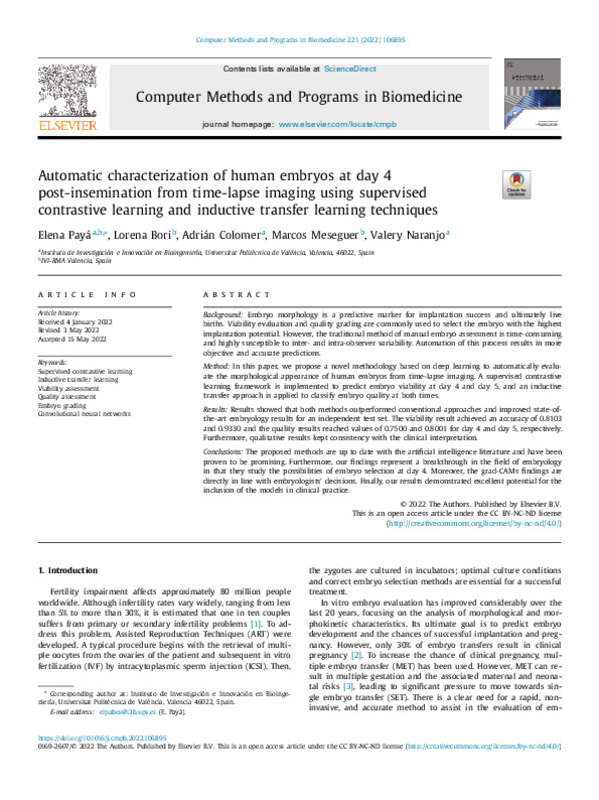JavaScript is disabled for your browser. Some features of this site may not work without it.
Buscar en RiuNet
Listar
Mi cuenta
Estadísticas
Ayuda RiuNet
Admin. UPV
Automatic characterization of human embryos at day 4 post-insemination from time-lapse imaging using supervised contrastive learning and inductive transfer learning techniques
Mostrar el registro sencillo del ítem
Ficheros en el ítem
| dc.contributor.author | Paya-Bosch, Elena
|
es_ES |
| dc.contributor.author | Bori, Lorena
|
es_ES |
| dc.contributor.author | Colomer, Adrián
|
es_ES |
| dc.contributor.author | Meseguer, Marcos
|
es_ES |
| dc.contributor.author | Naranjo Ornedo, Valeriana
|
es_ES |
| dc.date.accessioned | 2023-03-24T19:01:21Z | |
| dc.date.available | 2023-03-24T19:01:21Z | |
| dc.date.issued | 2022-06-01 | es_ES |
| dc.identifier.issn | 0169-2607 | es_ES |
| dc.identifier.uri | http://hdl.handle.net/10251/192603 | |
| dc.description.abstract | [EN] Embryo morphology is a predictive marker for implantation success and ultimately live births. Viability evaluation and quality grading are commonly used to select the embryo with the highest implantation potential. However, the traditional method of manual embryo assessment is time-consuming and highly susceptible to inter-and intra-observer variability. Automation of this process results in more objective and accurate predictions.Method: In this paper, we propose a novel methodology based on deep learning to automatically evaluate the morphological appearance of human embryos from time-lapse imaging. A supervised contrastive learning framework is implemented to predict embryo viability at day 4 and day 5, and an inductive transfer approach is applied to classify embryo quality at both times.Results: Results showed that both methods outperformed conventional approaches and improved state-ofthe-art embryology results for an independent test set. The viability result achieved an accuracy of 0.8103 and 0.9330 and the quality results reached values of 0.7500 and 0.8001 for day 4 and day 5, respectively. Furthermore, qualitative results kept consistency with the clinical interpretation. Conclusions: The proposed methods are up to date with the artificial intelligence literature and have been proven to be promising. Furthermore, our findings represent a breakthrough in the field of embryology in that they study the possibilities of embryo selection at day 4. Moreover, the grad-CAMs findings are directly in line with embryologists' decisions. Finally, our results demonstrated excellent potential for the inclusion of the models in clinical practice. | es_ES |
| dc.description.sponsorship | This work has been partially funded by Agencia Valenciana de la Innovacion (AVI) (2002-VLC-011-MM) . The work of Elena Pay Bosch has been supported by the Spanish Government (DIN2018-009911) and the work of Valery Naranjo Ornedo by the Generalitat Valenciana (AEST/2021/054) . We gratefully acknowledge the support from the Generalitat Valenciana with the donation of the DGX A100 used for this work, action co-nanced by the European Union through the Operational Program of the European Regional Development Fund of the Co-munitat Valenciana 2014-2020 (IDIFEDER/2020/030) . | es_ES |
| dc.language | Inglés | es_ES |
| dc.publisher | Elsevier | es_ES |
| dc.relation.ispartof | Computer Methods and Programs in Biomedicine | es_ES |
| dc.rights | Reconocimiento - No comercial - Sin obra derivada (by-nc-nd) | es_ES |
| dc.subject | Supervised contrastive learning | es_ES |
| dc.subject | Inductive transfer learning | es_ES |
| dc.subject | Viability assessment | es_ES |
| dc.subject | Quality assessment | es_ES |
| dc.subject | Embryo grading | es_ES |
| dc.subject | Convolutional neural networks | es_ES |
| dc.subject.classification | TEORÍA DE LA SEÑAL Y COMUNICACIONES | es_ES |
| dc.title | Automatic characterization of human embryos at day 4 post-insemination from time-lapse imaging using supervised contrastive learning and inductive transfer learning techniques | es_ES |
| dc.type | Artículo | es_ES |
| dc.identifier.doi | 10.1016/j.cmpb.2022.106895 | es_ES |
| dc.relation.projectID | info:eu-repo/grantAgreement/GENERALITAT VALENCIANA//AEST%2F2021%2F054//SISTEMA AUTOMÁTICO DE PREDICCIÓN DE LA CALIDAD../ | es_ES |
| dc.relation.projectID | info:eu-repo/grantAgreement/GV INNOV.UNI.CIENCIA//IDIFEDER%2F2020%2F030//INTELIGENCIA ARTIFICIAL EN LA NUBE APLICADO AL CAMPO DE LA PATOLOGIA DIGITAL / | es_ES |
| dc.relation.projectID | info:eu-repo/grantAgreement/MCIU//DIN2018-009911/ | es_ES |
| dc.relation.projectID | info:eu-repo/grantAgreement/AVI//2002-VLC-011-MM/ | es_ES |
| dc.rights.accessRights | Abierto | es_ES |
| dc.contributor.affiliation | Universitat Politècnica de València. Escuela Técnica Superior de Ingenieros de Telecomunicación - Escola Tècnica Superior d'Enginyers de Telecomunicació | es_ES |
| dc.description.bibliographicCitation | Paya-Bosch, E.; Bori, L.; Colomer, A.; Meseguer, M.; Naranjo Ornedo, V. (2022). Automatic characterization of human embryos at day 4 post-insemination from time-lapse imaging using supervised contrastive learning and inductive transfer learning techniques. Computer Methods and Programs in Biomedicine. 221(106895):1-12. https://doi.org/10.1016/j.cmpb.2022.106895 | es_ES |
| dc.description.accrualMethod | S | es_ES |
| dc.relation.publisherversion | https://doi.org/10.1016/j.cmpb.2022.106895 | es_ES |
| dc.description.upvformatpinicio | 1 | es_ES |
| dc.description.upvformatpfin | 12 | es_ES |
| dc.type.version | info:eu-repo/semantics/publishedVersion | es_ES |
| dc.description.volume | 221 | es_ES |
| dc.description.issue | 106895 | es_ES |
| dc.identifier.pmid | 35609359 | es_ES |
| dc.relation.pasarela | S\466303 | es_ES |
| dc.contributor.funder | GENERALITAT VALENCIANA | es_ES |
| dc.contributor.funder | European Regional Development Fund | es_ES |
| dc.contributor.funder | Agència Valenciana de la Innovació | es_ES |
| dc.contributor.funder | Ministerio de Ciencia, Innovación y Universidades | es_ES |
| dc.contributor.funder | Universitat Politècnica de València | es_ES |








